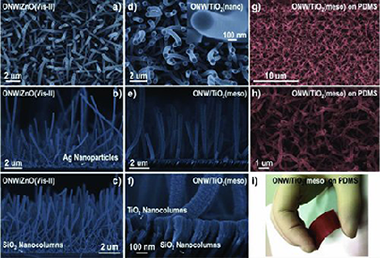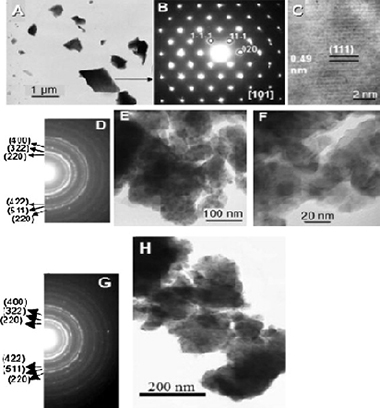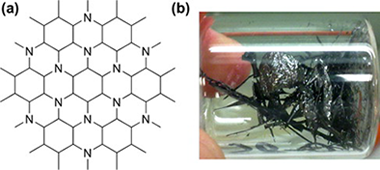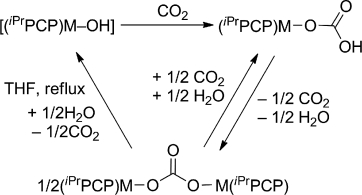Artículos SCI
2013
2013
Nanotecnología en Superficies y Plasma
Vertically Aligned Hybrid Core/Shell Semiconductor Nanowires for Photonics Applications
Macias-Montero, M; Filippin, AN; Saghi, Z; Aparicio, FJ; Barranco, A; Espinos, JP; Frutos, F; Gonzalez-Elipe, AR; Borras, AAdvanced Functional Materiales, 23 (2013) 5981-5989
Show abstract ▽

A family of 1D organic/inorganic core/shell materials formed by an inner organic nanowire (ONW) conformally covered with an inorganic wide band gap semiconductor (ZnO or TiO2) layer is presented. The developed procedure is a two-steps vacuum methodology involving the formation of supported single crystal small-molecule nanowires by physical vapor deposition and plasma enhance chemical vapor deposition (PECVD) of the inorganic shell. Critical characteristics of the last technique are the possibilities of low temperature and remote configuration deposition. Additionally, an initial step has to be included in order to create nucleation centers for the growth of the ONWs. The procedure and its general character in terms of the variability in organic core and inorganic shells composition and the applicability of the technique to different substrates are presented. The formation of the inorganic shell with no damage of the organic core single-crystalline structure is demonstrated by high resolution transmission electron microscopy. The vertical alignment of the hybrid nanostructure is achieved thanks to the interaction of the 1D organic nanostructured surfaces and the glow discharge during the deposition of the inorganic shell by PECVD. The optical properties of these core/shell NWs are studied by fluorescence spectroscopy and microscopy, and their application as nanoscale waveguides in the 550–750 nm range addressed.
Diciembre, 2013 | DOI: 10.1002/adfm.201301120
Reactividad de Sólidos
Arsenic sorption by nanocrystalline magnetite: An example of environmentally promising interface with geosphere
Bujnakova, Z; Balaz, P; Zorkovska, A; Sayagues, MJ; Kovac, J; Timko, MJournal of Hazardous Materials, 262 (2013) 1204-1212
Show abstract ▽

In this paper, the sorption of arsenic onto nanocrystalline magnetite mineral Fe3O4 was studied in a model system. Nanocrystalline magnetite was produced by mechanical activation in a planetary ball mill from natural microcrystalline magnetite. As a consequence of milling, the specific surface area increased from 0.1 m2/g to 11.9 m2/g and the surface site concentration enhanced from 2.2 sites/nm2 to 8.4 sites/nm2. These changes in surface properties of magnetite lead to the enhancement of arsenic removal from model system. The best sorption ability was achieved with magnetite sample activated for 90 min. In this case the sample was able to absorb around 4 mg/g. The structural changes of magnetite were also observed and the new hematite phase was detected after 120 min of milling. A good correlation between the decreasing particle size, increasing specific surface area and reduction of saturation magnetization was found. In desorption study, KOH and NaOH were found as the best eluents where more than 70% of arsenic was released back into the solution. The principal novelty of the paper is that mineral magnetite, truly one nature's gift can be used after “smart” milling (mechanical activation) as an effective arsenic sorbent.
Noviembre, 2013 | DOI: 10.1016/j.jhazmat.2013.03.007
Nanotecnología en Superficies y Plasma - Materiales y Procesos Catalíticos de Interés Ambiental y Energético
A single-source route to bulk samples of C3N and the co-evolution of graphitic carbon microspheres
King, TC; Matthews, PD; Holgado, JP; Jefferson, DA; Lambert, RM; Alavi, A; Wright, DSCarbon, 64 (2013) 6-10
Show abstract ▽

The thermolysis of commercially available m-phenylenediamine (1,3-(NH2)2C6H4) at 800 °C under a static vacuum in a sealed quartz tube provides the first bulk synthesis of C3N, whose properties have only been predicted theoretically previously. Hollow carbon microspheres (CMSs) which do not contain significant nitrogen doping (1–3 μm diameter) are co-produced in the reaction and readily separated from the C3N flakes. The separate C3N flakes and CMSs have been characterized by electron microscopy, X-ray spectroscopy and X-ray diffraction. These studies show that the samples of C3N and CMSs both possess multi-layered turbostratic graphitic structures. A new mechanism for the template-free assembly of CMSs is proposed on the basis of electron microscopy that involves bubble evolution from a static carbonized layer.
Noviembre, 2013 | DOI: 10.1016/j.carbon.2013.04.043
Reactividad de Sólidos
Formation mechanism of ZrB2–Al2O3 nanocomposite powder by mechanically induced self-sustaining reaction
Jalaly, M; Bafghi, MS; Tamizifar, M; Gotor, FJJournal of Materials Science, 48 (2013) 7557-7567
Show abstract ▽
ZrB2–Al2O3 nanocomposite powder was produced by aluminothermic reduction in Al/ZrO2/B2O3 system. In this research, high energy ball milling was used to produce the necessary conditions to induce a mechanically induced self-sustaining reaction. The ignition time of the composite formation was found to be about 13 min. The synthesis mechanism in this system was investigated by examining the corresponding sub-reactions as well as changing the stoichiometry of reactants. Thermal behavior of the system was also studied.
Noviembre, 2013 | DOI: 10.1007/s10853-013-7571-7
Reactividad de Sólidos
Reversible reactions of Ni and Pd hydroxo pincer complexes [( iPrPCP)M-OH] with CO2: Solid-state study of the decarboxylation of the monomeric bicarbonate complexes [(i PrPCP)M-OCOOH] (M = Ni, Pd)
Martinez-Prieto, LM; Real, C; Avila, E; Alvarez, E; Palma, P; Campora, JEuropean Journal of Inorganic Chemistry, 32 (2013) 5555-5566
Show abstract ▽

Monomeric Ni and Pd hydroxides stabilized by the iPrPCP pincer ligand react with CO2 to give labile terminal bicarbonate complexes that readily lose CO2 and water to give binuclear carbonate complexes. Differential scanning calorimetry (DSC) has been used to monitor the decomposition of both bicarcabonates in the solid state. When the carbonate complexes are heated under reflux in thf in the presence of water, full decarboxylation takes place, restoring the starting hydroxides and demonstrating that CO2 insertion is a fully reversible process. The decarboxylation of the nickel carbonate complex is completed more readily, suggesting that the reaction of the Pd hydroxide with CO2 is more favourable than that of its nickel counterpart. This is supported by DFT calculations, which also shows that CO2 insertion takes place through a concerted Lipscomb-type mechanism. Monomeric Ni and Pd hydroxides stabilized by the iPrPCP pincer ligand react with CO2 to give labile terminal hydrogen carbonate complexes that readily lose CO2 and water to give binuclear carbonate complexes.
Noviembre, 2013 | DOI: 10.1002/ejic.201300995
- ‹ anterior
- 290 of 420
- siguiente ›














